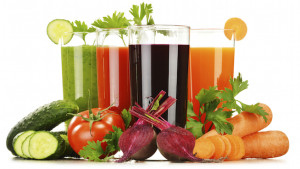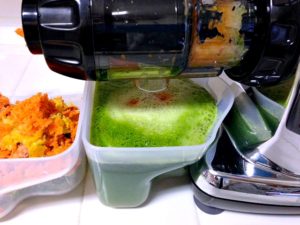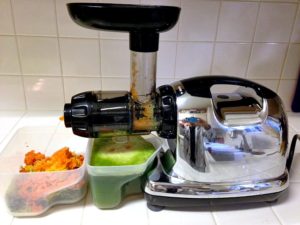A Great Way to Add a Nutritional Punch to Your Diet!

Juicing is a great way to consume more vegetables – however it shouldn’t replace all the veggies in your diet – you should still EAT vegetables when you’re juicing too!
For optimal nutritional absorption, you want to juice vegetables alone, and not mix them with fruit. The reason is that the enzymes to digest vegetables are different from the enzymes that digest fruit. And when these enzymes are combined, it makes for bad digestion. And some sensitive people will have stomach aches. The exception are apples because they have a neutral effect.
It’s not horrible to combine both fruits & veggies when juicing, but again, if you want optimal nutritional absorption, juice veggies alone. Also, fruits are much higher in sugar than vegetables, and when you juice fruits, you are removing the fiber, which helps slow down the release of the sugar that’s in the fruits. So for fruit, nutritionally it’s best to eat it whole rather than juicing it. Another option is to make fruit smoothies; that way, the fiber is not removed.

Try to use ORGANIC produce for juicing whenever possible!
I strongly recommend using organic vegetables as much as possible. If organic produce isn’t easily available, here’s an easy “produce soak” that can remove as much as 99% of the contaminants on regular produce!
Here’s what I would juice: When juicing, it’s best to make it and drink it shortly after you make it. If you need to, you can store it for up to 24 hours with moderate nutritional decline, in a sealed glass container and fill it to the very top.
Drinking your juice first thing in the morning on an empty stomach can give you a natural energy boost without resorting to stimulants like coffee.
I know that juicing greens can be bitter or yucky, so if you’re new to juicing, you can start with more mild-tasting veggies, like celery and cucumbers.

From there, you can work your way up to red leaf lettuce, romaine lettuce, spinach, etc. Greens like kale, and collard greens are quite bitter, so you’ll want to start slowly and add just a few leaves at a time. You will find that you will get used to the taste of greens juice.
organic green apple, organic cucumber (or organic celery for a high water content base), organic kale and/or organic spinach, lemon (for added vitamin C & to take off the bite of the greens), organic Italian parsley (great for detox & digestion), and a little bit of organic ginger (for detox and zing)
Here’s some juicing suggestions:
Base – Organic Cucumber or Celery
Organic Greens – 1 cup of Romaine
Add 3-5 leaves of: Watercress, Chinese Napa Cabbage, Chard, Beet Greens, Spinach, Chicory, Collard Greens, or Kale
For sweetness – Organic Carrots or Beets
Organic Green Apple (green apples have less sugar)
Lemon or Lime (for added vitamin C & to take off the bite of the greens)
Organic Italian Parsley (great for detox & digestion
Organic Ginger (for detox and zing)
It’s best to “rotate” your greens weekly and use different greens – try not to use the same greens all the time.
There are many more excellent vegetables you can use for juicing – the limit for mixing and matching is only your imagination!
If you don’t have a juicer yet, the best juicer for greens and vegetables is a slow masticating juicer. The high speed juicers can kill some of the nutrients in the vegetables. For optimal health, use a slow masticating juicer, and drink your greens juice fresh, within minutes of juicing.
If you have any aging concerns, let me help you.
Drop me a line anytime, and I or one of my representatives will respond to you as soon as possible.
